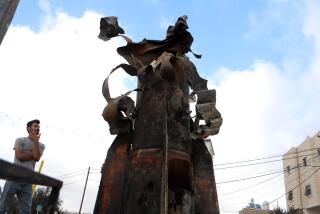THE BOMB : Hiroshima: Changing the Way We Think About War
- Share via
SOUTH ROYALTON, VT. — The bombs that destroyed Hiroshima and Nagasaki and ended the war in the Pacific 50 years ago changed forever the way people think about science, war and international politics. But while some felt the bombs had introduced a new dark age of barbarism, in which human technical genius threatened to destroy us all, others decided the bomb offered a cheap and useful tool for keeping the peace.
This hopeful attitude was at first hidden by the sheer horror of what happened on the ground--the scores of thousands who died of blast, heat and radiation, and the cities reduced to a waste of blackened rumble over a palimpsest of streets. U.S. military authorities in Japan did their best to keep journalists away from the grim facts but the public got the picture--no painter’s vision of hell could match the reality at ground zero. The darkening of the modern mind, begun in the nightmare of the trenches of the Western Front in World War I, was completed at Hiroshima. In the half-century since, no one paying attention has been free for a day from the fear that it will happen again.
But it has not happened again. Credit for this happy but unexpected turn of events must be shared--in what proportion it is hard to say--by the workings of Divine Providence and by the U.S. military policy of reliance on nuclear weapons, lots of them, for that sober circumspection in the minds of potential enemies that we call deterrence. Critics warned that the embrace of nuclear weapons for defense would prove fatal. But the White House and the Pentagon never looked back, and the history of the Cold War is largely the history of the arms race that paced it--a spiraling growth of nuclear weapons in numbers and sophistication that ended in the 1980s with the bankruptcy and collapse of the Soviet Union.
The public discussion of Hiroshima in recent weeks, reaching a climax all over the world today, has focused on the decision itself: Was it necessary to destroy Hiroshima to end the war promptly and save countless lives, American and Japanese alike? Or were the Japanese so close to admitting defeat that even a promise by President Harry S. Truman not to depose or arrest the emperor would have been enough to end the fighting?
Barely hidden by this is the more dangerous question: Was it right. To call Hiroshima “unnecessary” comes close to asking whether it was wrong, something to be ashamed of, to apologize for. By their nature such questions can be clarified, but never truly answered. The morality of an act is not an absolute quality, like mass or velocity. Ignored in this long argument about necessity has been the principal legacy of Hiroshima--which is not so much a memory of horror as a revolution in the way nations think about and prepare for war.
On the day Hiroshima died, the U.S. under-secretary of war, Robert Patterson, cabled his congratulations to the scientists at Los Alamos, insisting it was no time to slack off--efforts must be redoubled to keep the peace. The man who replaced J. Robert Oppenheimer as the laboratory’s director, Norris Bradbury, spent the next 25 years refining the bomb. Its destructive power dwarfed all previous weapons, but the bomb was heavy, hard to deliver, dangerous to handle, subject to decay if left unused. Bradbury set out to fix all that; and he and his colleagues and eventually his rivals at a second bomb laboratory in Livermore, Calif., made the bomb in every way a more convenient, trustworthy and lethal instrument of war.
Because the bomb--any bomb--is supremely dangerous, the difference between having one and not having one is far, far greater than the difference between having a basic device and having a sophisticated fourth-generation weapon that can fit on the end of an artillery shell, or deliver a flood of designer radiation. But the truth is modern American bombs bear as much relation to Fat Man and Little boy as a new PC with a pentium chip and an 80-megabyte hard drive bears to an abacus.
The zillions of dollars spent on nuclear warheads and their delivery systems over the last half-century resulted in weapons that can destroy anything on or within a few hundred feet of the surface of any known location on the face of the earth. In the mid-1980s, these tens of thousands of weapons were tightly wired to warning systems and computer-driven war-fighting strategies that, set in motion, probably could not have been halted short of the destruction of every society more complex than an ant colony. This perfection of the nuclear infrastructure was intended to make war so “possible” that it was, in effect, “impossible”--too dangerous to justify any conceivable gain.
No one ever dreamed, back in the late 1940s, when the word deterrence first came into general use, that things would ever get to such an extreme. If they had known, they would have been too frightened to try it. But the arms race got more dangerous one spiral at a time, and no one could think of a way to switch strategies in mid-spiral. As things turned out, the policy of deterrence worked--there was no war.
The reason for the deep reliance on nuclear weapons in postwar U.S. national-security policy can be explained in one word: money. The laboratories, the bomber and missile fleets, the nuclear submarines, reconnaissance satellites and underground command posts all cost trillions--but they were cheap compared to men in uniform.
The point of no return occurred early in President Dwight D. Eisenhower’s first term, about the time it became clear that the war in Korea would be settled by negotiation. War fears that blossomed during the 1948 Berlin blockade had quieted; the Cold War rivals had settled into a mood of permanent confrontation short of war, and the Soviet ability to put millions of men under arms indefinitely challenged the ability of Western democracies to match them division for division. Democracies can be effective wagers of war, as Adolf Hitler discovered, but they do not like paying for it. The only long-term counterweight to huge Soviet standing armies, Eisenhower and his advisers decided, was the bomb.
This strategy had an enduring simplicity. Enough U.S. soldiers would be stationed in Germany to insure heavy losses in the event of Soviet attack, thus forcing Washington to fight. To make sure it could fight, nuclear forces would be deployed of a kind and quantity guaranteeing the United States would not lose any war--and might even win, if at terrific cost. The resulting standoff grew steadily throughout the Cold War; the Soviets never quit building tanks or missiles until the collapse of the late 1980s.
Their goal was “decoupling”--building Soviet nuclear forces we could not sanely threaten to provoke under any circumstances, thereby leaving the conventional armies, where the Soviets had an advantage, to face each other without recourse to the nuclear big brother. In such circumstances we could no longer come to the defense of Europe; our fates would be “decoupled” and the Soviets would be free to deal with us one at a time. Discussion of the subtleties of this strategy, with its endless cycles of we-do-this then-they-do-that, were described as the “theology of nuclear deterrence.” Whether it had ceased to be sane long before the end is hard to say. But one thing is clear: Throughout the Cold War, the Soviets never doubted that an attack on U.S. forces in Europe would have brought an American nuclear response.
If money explains American reliance on nuclear weapons, it also explains the Soviet collapse. The Americans bleated in pain at the hemorrhage of money, but the Soviets ran out of it. Lots of Americans argued that President Ronald Reagan’s “Star Wars” program to build a defense against Soviet missiles would never work--but the Soviets knew it would work well enough to force them to build one, too, and they knew it would cost 10 fortunes on top of the fortunes already spent on nuclear forces. After Mikhail S. Gorbachev called in the accountants and examined the real books on income and outgo, they knew they didn’t have the money. The house of cards did not stand long thereafter.
The 50th anniversary of Hiroshima offers a good moment to recount this brief outline of nuclear history. The horror of what happened there has been often described. Scores of thousands died who had done nothing to deserve it--and died in ways that tempt us to stop our ears and avert our eyes. Still the world cannot agree on whether the bombing of Hiroshima was necessary or right. It is human nature not to agree.
But the horror of Hiroshima was not without effect. Its legacy was fear. The world’s leaders all got the picture. They hurried to get nuclear weapons of their own--but were careful not to use them. The Americans and Soviets built so many they glowered at each other for a half-century without coming to blows. We must credit Hiroshima and the bomb in some measure for this run of luck. But some credit also belongs to Divine Providence, which, I believe, would urge us not to try it twice.*
More to Read
Sign up for Essential California
The most important California stories and recommendations in your inbox every morning.
You may occasionally receive promotional content from the Los Angeles Times.













